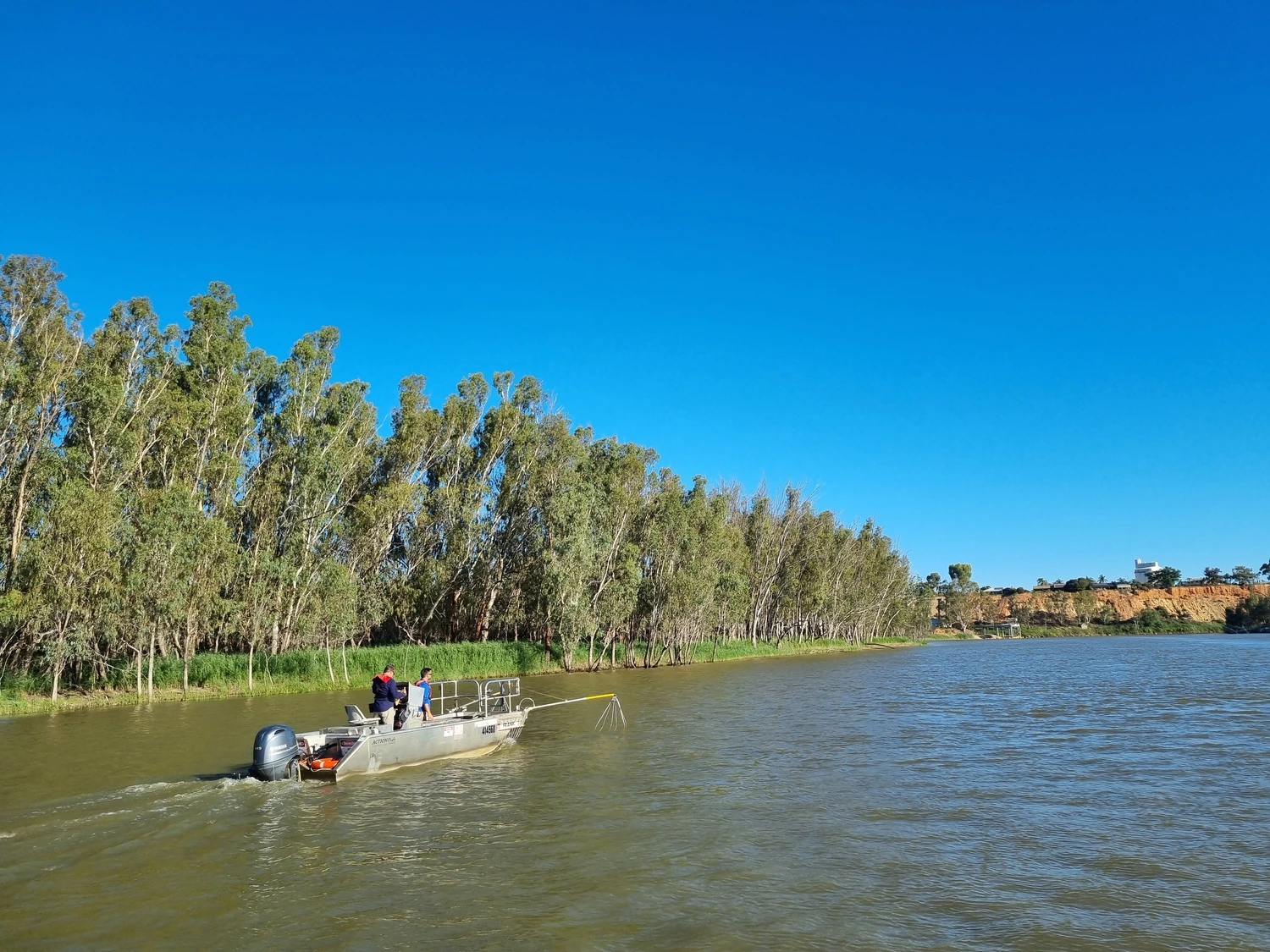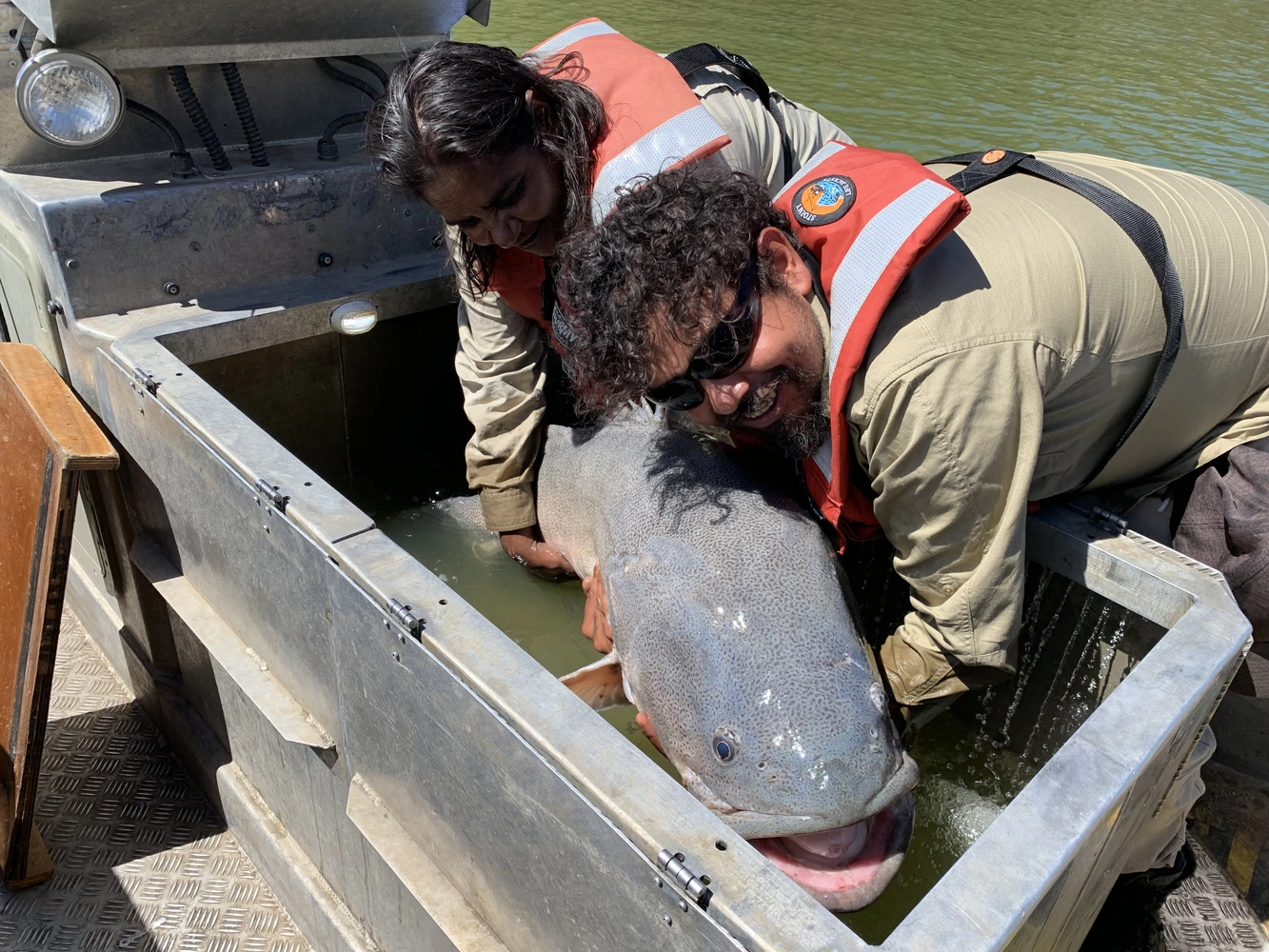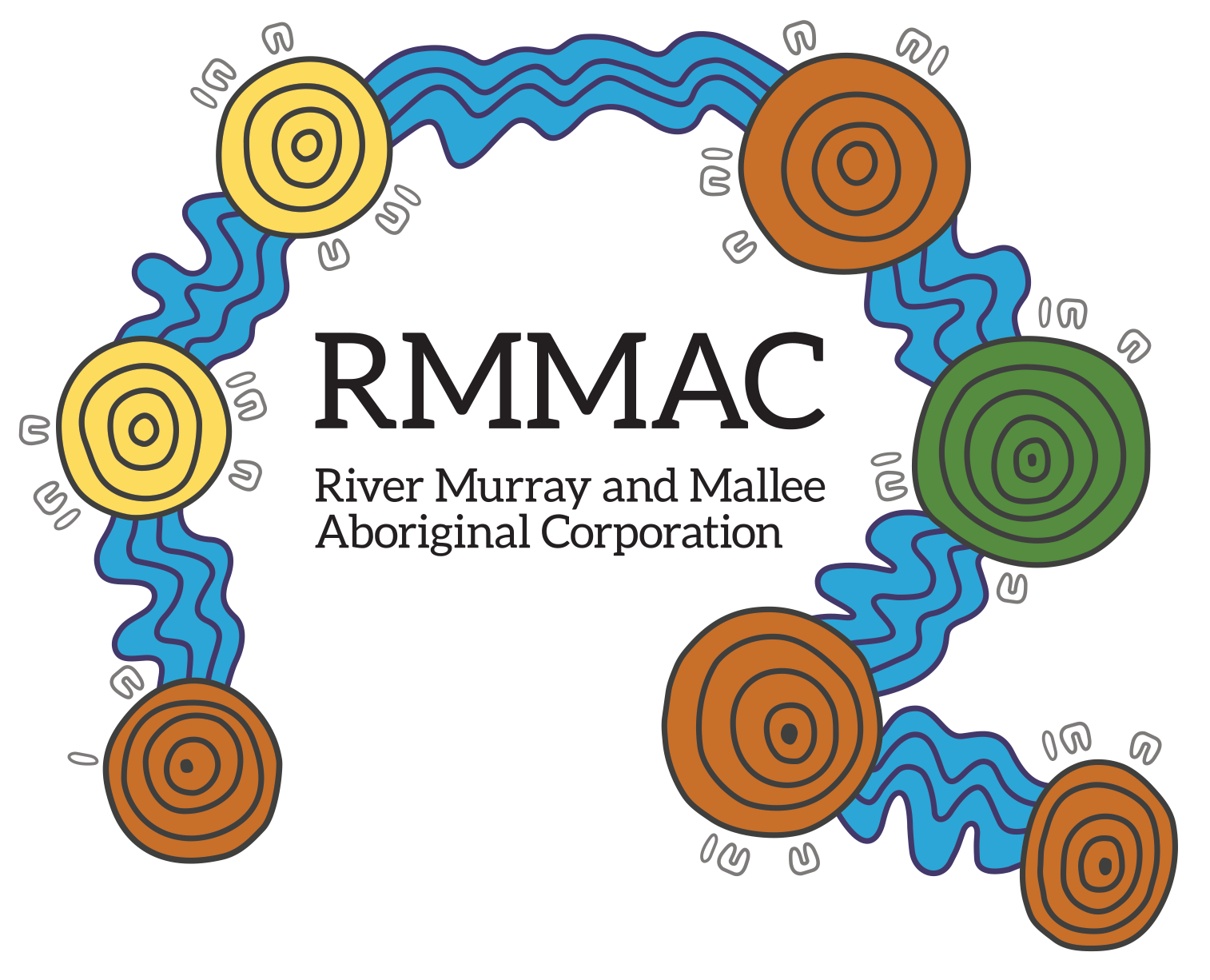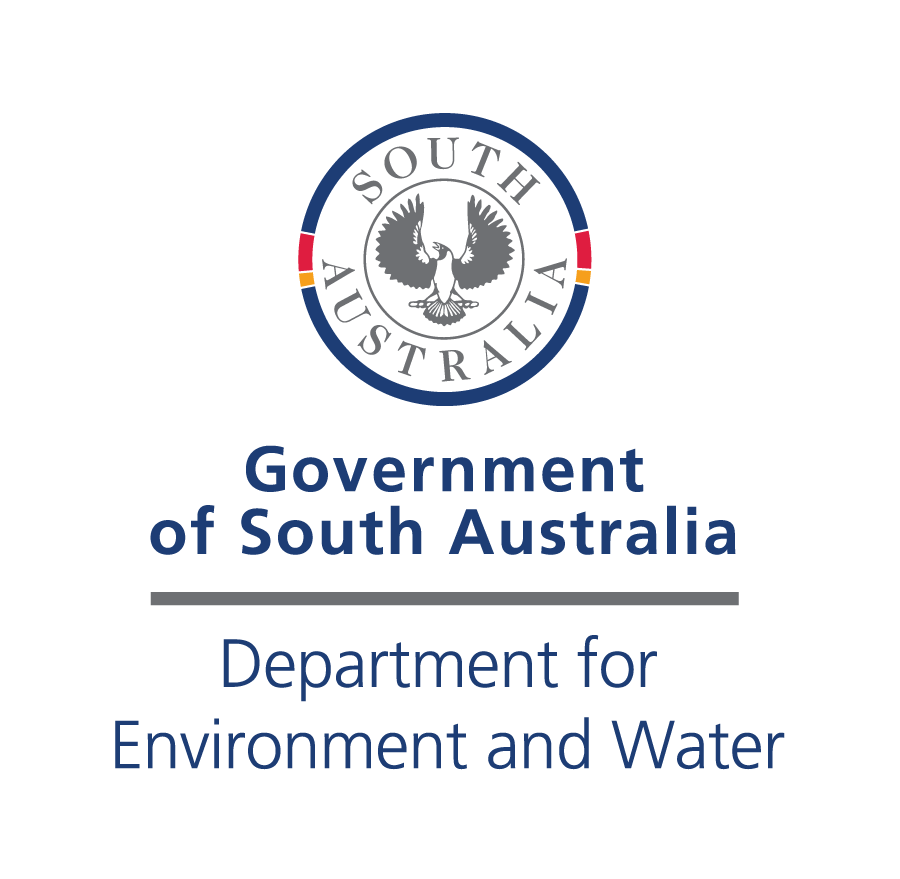Lower Murray and Coorong, Lower Lakes, and Murray Mouth
Banner Image: A view of the floodplain from a clifftop in the Lower Murray. Note the high water due to flooding. Photo credit: SARDI
About the Area
The Lower Murray and Coorong, Lower Lakes and Murray Mouth (CLLMM) Area includes the Murray River beginning from Mildura in New South Wales and extends to the Lower Lakes (Lakes Alexandrina and Albert), Coorong and Murray Mouth in South Australia. The Area features the First Nations ancestral lands of the Ngarrindjeri, Nganguraku and Ngaiwang Nations and the First Peoples of the River Murray and Mallee.
As the Lower Murray and CLLMM is at the end of the Murray–Darling Basin, flow to the Area is affected by both the northern and southern basins. The hydrology of the Area has been greatly altered by regulation and flow diversions, including the construction of multiple low-level (<3 m) weirs and five tidal barrages.
Historically, Commonwealth environmental water has been delivered to the Lower Murray, in conjunction with other environmental flows to maximise effectiveness. These flows support riverine base flows, spring freshes and wetland and floodplain watering in the Lower Murray. They also maintain water levels in the Lowe Lakes, provide flows for fishway operations and support barrage flow releases to the Coorong.

Light reflections on the water in the Valley Zone a typical habitat found in the Lower Murray. Photo credit: South Australian Research and Development Institute.


Electrofishing vessel ‘Frank’ on the Lower Murray River undertaking field sampling. Photo credit: South Australian Research and Development Institute.

A group of pelicans massing to catch fish with barrage flow releases from the Lower Lakes into the Coorong estuary. Photo credit: South Australian Research and Development Institute.
Our Work
Learn about the main activities taking place in this Area.
River Flows and Connectivity
This theme assesses how Commonwealth environmental water restores flow regimes and hydrological connectivity of water dependent ecosystems in the Basin. This will be measured by hydrological and hydraulic modelling, forecasting flow effects under different delivery scenarios and actual flow data.
Native Fish
Native fish are important indicators of the health of river ecosystems. This monitoring will focus on how flow regimes and water for the environment will affect fish population characteristics including year-class strength and proportions of juveniles and adults. Fish abundance, reproduction and body condition will also be assessed. Key species include Murray cod, golden perch, silver perch and freshwater catfish.
Monitoring will be conducted using annual electrofishing surveys, and bongo net tows for larval sampling during key spawning times. Selected sites will include all reaches of the Murray River from Mildura through to below Lock 1 in South Australia.
Additionally, the influence of water for the environment on Murray barrage fishway function and connectivity, and the upstream migration of diadromous species, including pouched lamprey, will be evaluated using annual survey data from The Living Murray barrage fishway monitoring.
Cultural Outcomes
This theme provides an opportunity to evaluate the contribution of Commonwealth environmental water in meeting cultural outcomes in the Lower Murray and CLLMM Area. A significant emphasis will be on co-development of projects: this will enable First Nations groups to determine their own cultural values, perspectives and priorities.
Key objectives include the following:
- Maintain or enhance First Nations cultural practices.
- Improve key indicators - living things, cultural places/sites and cultural activities.
- Enhance First Nations participation through the planning, delivery and evaluation of MER projects/activities.
- Strengthen relationships between First Nations people, CEWH staff and scientists.
Native Vegetation
This theme will assess the health and status of submergent aquatic plants in lakes Alexandrina and Albert. The annual survey data from The Living Murray vegetation condition monitoring will be used. The evaluation will be undertaken through assessing the effect of Commonwealth environmental water on lake levels. These levels will then be used to predict the condition of submergent vegetation and diverse reed beds with comparison under different water delivery scenarios.
Knowledge Exchange, Communication and Engagement
Key approaches to be employed to maximise the effective transfer of knowledge and engage stakeholders in Flow-MER include:
- Informing- Sharing information via traditional methods such as publications, websites, social media etc.
- Consulting/Involving- Holding meetings, seminars, workshops and events.
- Collaborating-Empowering- Fostering and building relationships, partnering with organisations, providing mentoring and training.

First Nations Activities
The Lower Murray and CLLMM project team supports a culturally safe and staged approach to First Nations activities. The expected outcomes of the program will mature and evolve through implementing collaborative activities and strengthening the trust with existing First Nations partners, the new relationships built over the life of the program.
Our key partners include the Ngarrindjeri Aboriginal Corporation and River Murray and Mallee Aboriginal Corporation. We have engaged Cultural Advisors to co-design and drive the First Nations activities and evaluate Cultural Outcomes for this Area. We are also working with CSIRO through the River Murray Monitoring project to build our relationship with First Nations people in the upper Lower Murray region.
We will build upon a number of strongly supported activities developed during the past decade of the Flow-MER Program. These include:
- Indigenous Ecology in Action Workshop
- Lower Murray Mural
- Aboriginal Rangers Insight Program
- Pondi (Murray Cod) Monitoring Project
Overall, our actions will focus on enhancing First Nations involvement; supporting self-determination; and integrating diverse knowledges.

Matter Transport & Coorong Habitat
Flow provides habitat and resources for aquatic organisms by altering the concentrations and transport of dissolved and particulate matter. The concentration of these resources has significant implications for the survival or otherwise of aquatic species in the Lower Murray. Of particular importance is salt and its export from the system into the ocean.
This indicator intends to assess whether flow and water for the environment (and specifically Commonwealth environmental water) has increased the transport and export of salt, nutrients and phytoplankton through the Lower Murray. It also assesses how this affects salinity regime and the habitats of fish and aquatic plants in the Coorong. Hydrodynamic and biogeochemical computer models will be used for the assessment and evaluation.

Research
A critical part of the Flow-MER Program in this Area is to undertake targeted research activities to contribute to:
- Support adaptive management of environmental water to enhance outcomes of water management.
- Support and enhance evaluation of environmental flow responses at Area-scale.
Our initial research includes the investigations on:
- The role of environmental flows in determining the nutrient budget of the Coorong.
- Enabling the evaluation of hydraulic improvements from environmental water and weir pool manipulation for Weir Pools 6 to 9.
- Development of a Ruppia megacarpa model for the Coorong to enable the evaluation of environmental water on the suitable habitat for that species in the Coorong.


Key Insights
Environmental water for restoration
In the Lower Murray River (LMR), environmental water can be used to help restore key features of the natural hydrograph to support hydrodynamic and ecosystem restoration.
Spring flows and ecological benefits during dry years
During dry years, spring flow pules created by environmental water have led to small to moderate increases in flowing water habitat and improvement in river connectivity. These supported a range of ‘reach-scale’ responses, including mitigating the risk of low dissolved oxygen in water, benefiting littoral vegetation in tailwaters and Murray cod recruitment; and broader-scale responses like downstream transport of fish larvae and microinvertebrates, and lower levels of reproduction of flow-cued spawning fish (i.e. golden perch and silver perch). Notably, such ecological improvements associated with elevated flows may play an important ‘maintenance’ role for populations and the LMR during ‘drier’ periods between natural high flows.
Large flow pulses for fish spawning and recruitment
Larger flow pulses >20,000 ML/d are required to restore riverine characteristics to the LMR and achieve ecological outcomes of greater magnitude (e.g. significant spawning and recruitment of golden perch). During wet years, environmental water can be delivered alongside unregulated flows to sustain high in-channel flows (>20,000 ML/d), as demonstrated in 2021-22 and 2023-24. Such flows significantly improve hydraulic conditions (>60% lotic habitat with velocity >0.3 m/s) and promote extensive longitudinal connectivity across the riverine system to achieve substantial ecological outcomes. For example, there was strong recruitment of golden perch in the LMR in 2021-22 resulting from a variety of spatially distinct spawning sources, including the Darling, mid-Murray and LMR.
Maintaining flow integrity
Maintaining ‘flow integrity’ - the characteristics (i.e. volume, water quality and constituents) of a parcel of water – from upstream reaches (e.g. Darling River or mid-Murray) downstream to the LMR is important to support broad-scale ecological processes (e.g. zooplankton and larval fish transport) and promote positive outcomes.
Optimising flows for different native fish species
The timing of flow pulses is likely to affect ecological outcomes. Water delivery should continue to align with ecological objectives and consider biological processes and species’ life history requirements. For example, flow pulses from mid-October to mid-November may benefit Murray cod recruitment, while flows in later November–January coincide with the spawning season of golden perch. To achieve multiple species outcomes, a holistic approach in flow regime design will be required, which may involve planning for multiple years to achieve different outcomes. This could be informed by multi-years data/learnings from different flow regimes (timing, magnitude, duration, etc.).
.jpg)
Native fish eggs collected during larval tow net sampling near Blanchetown in 2024. They resemble small clear crystal spheres. Photo credit: South Australian Research and Development Institute.

Golden perch larva collected during larval tow net sampling and a juvenile (~4 month old) Murray cod sampled during an electrofishing survey. Photo credit: South Australian Research and Development Institute.
River productivity and secondary production
In the heavily regulated LMR, the influence of environmental water on primary production (averaged over the monitoring period) is restricted by the stable water levels that characterise weir pool environments during in-channel flows. However, stream metabolism data highlight that river productivity was dominated by secondary production during high flows, with increased supplies of dissolved organic carbon compared to dry years. River productivity isn’t solely driven by primary production. Sustained high flows (including environmental water) can also benefit riverine food webs through improving heterotrophic production (i.e. carbon input from the floodplain and wetlands).
Supporting end-of-system flows
Finally, environmental water is critical in supporting end-of-system flows. Barrage flows are important to flush out salt from the entire Murray-Darling Basin, reduce salt import into the Coorong, and reduce salt flux into the North and South lagoons. This helps to reduce salinity across the basin and maintain estuarine habitat and ecosystem function within the Coorong, which is critical to support numerous species and biodiversity.
Importance of monitoring and science
Long-term monitoring and robust science are needed to inform environmental water delivery and flow management.

Dr Matt Gibbs (CSIRO) and Assoc Prof. Matt Hipsey (University of Western Australia) undertaking hydrodynamic modelling for the Lower Murray and CLLMM Area. Photo credit: CSIRO
Latest News
Annual reports, quarterly snapshots and implementation plans for the Lower Murray and Coorong, Lower Lakes and Murray Mouth can be found on the Commonwealth Environmental Water Holder (CEWH) website.
News
Webinars
Videos
Lower Murray Cultural Mural
Electrofishing in Action
Flow & Fishes of the Lower River Murray
Murray Flow for the environment
Sharing Our Science in the Lower Murray
Restoring flows to the Lower Murray
Our Team
A consortium, led by the South Australian Research and Development Institute / The University of Adelaide has been engaged by the CEWH to conduct Flow-MER activities in the Lower Murray and Coorong, Lower Lakes, and Murray Mouth from July 2024 to June 2029.

South Australian Research and Development Institute
Partners

University of Adelaide

CSIRO

University of Western Australia

River Murray and Mallee Aboriginal Corporation (RMMAC)

Ngarrindjeri Aboriginal Corporation (NAC)

Department for Environment and Water










